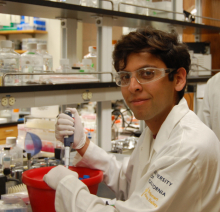
Major:
University:
Mentor(s):
Faculty Sponsor(s):
Faculty Sponsor's Department(s):
Project Title:
Project Description:
Contact dependent growth inhibition (CDI) is a toxin delivery system present in certain strains of bacteria used to poison and kill competing bacteria in the environment. CDI is significant to human health as it is present in many bacteria naturally present in the human body and also in human pathogens such as Escherichia coli. Many features of CDI toxin delivery are presently not understood such as how CDI toxins recognize and cross their target’s inner membrane. We aim to understand this phenomenon. We have probed interactions between the E. coli EC3006 toxin and its putative inner membrane receptor, the glucose importer PtsG. We have optimized EC3006 specificity domain and full length protein purifications. We have also optimized PtsG purification. No detectable interaction was observed between the toxin domains and lipids isolated from the E. coli inner membrane. However, there is evidence of increased degradation of the specificity domain missing highly conserved cysteines when in the presence of E. coli spheroplasts, implying direct interaction with a protease present in the inner membrane. Protealytic degradation has been shown to be important for the action of other bacterial toxins like colicins. We propose that reduction of a conserved disulfide at the inner membrane renders part of the toxin sensitive to protealytic degradation and that this phenomenon may be important to the mechanism of CDI toxin delivery to the cytoplasm.
